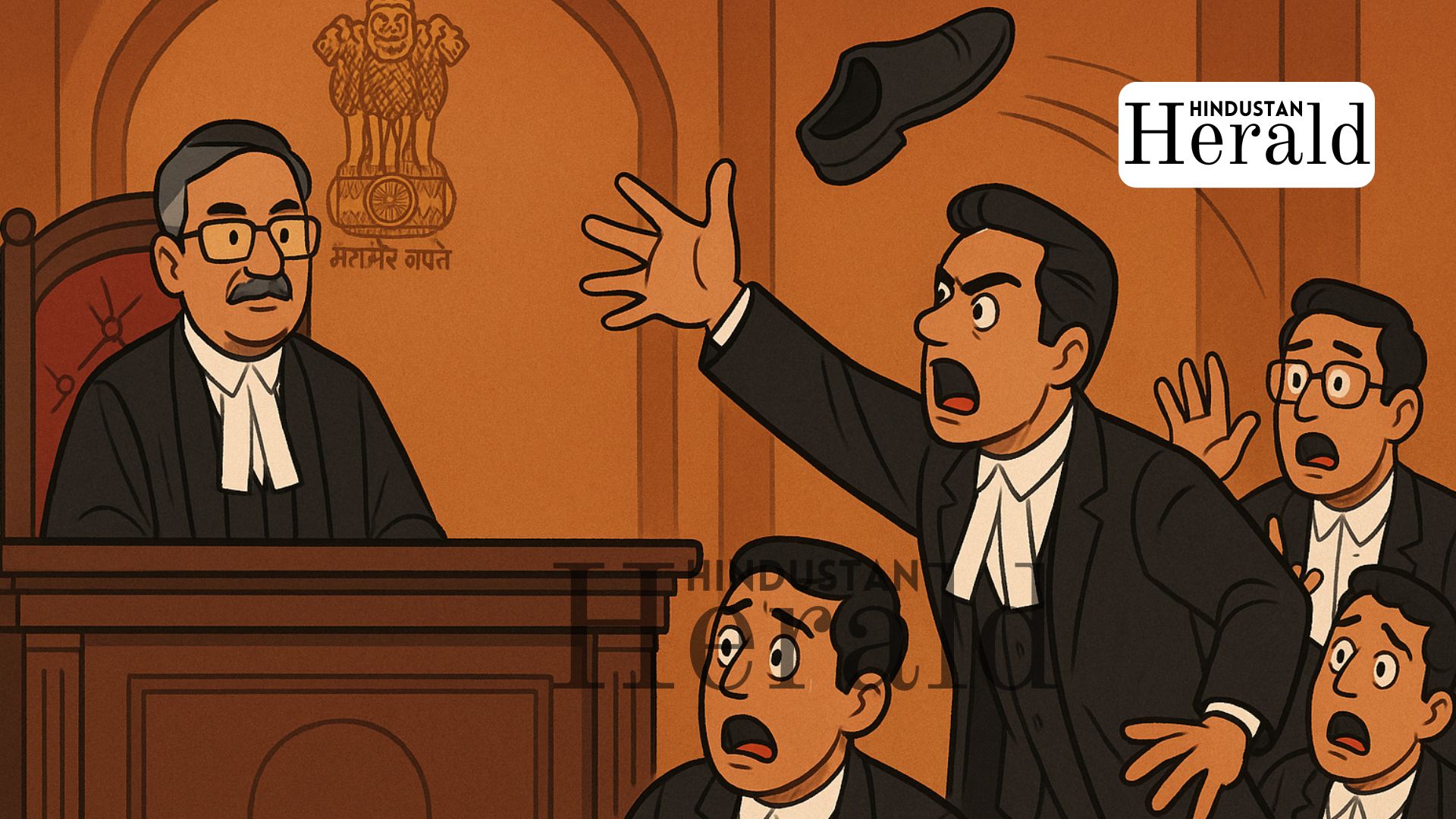New Delhi, October 6: A routine morning at the Supreme Court turned surreal today when a lawyer tried to hurl a shoe at Chief Justice of India B. R. Gavai during proceedings. The object didn’t reach the bench. The courtroom gasped, security lunged, and the man still wearing his black coat was wrestled out as he shouted, “Sanatan ka apmaan nahi sahenge.”
For a few seconds, India’s most solemn courtroom looked more like a protest ground than the sanctum of constitutional authority.
A Morning That Broke Decorum
Eyewitnesses say it all happened in a flash. The man, later identified as Rakesh Kishore, a 71-year-old advocate from Mayur Vihar, stood up, slipped off his shoe, and flung it toward the Chief Justice. It landed far short of the dais. Court security, normally discreet and still, reacted instantly. Within moments, the lawyer was out of the room, still shouting about “Sanatan Dharma” and “justice for faith.”
According to The Indian Express, Kishore was upset over comments made by CJI Gavai in September while hearing a plea related to the restoration of a damaged Lord Vishnu idol in Khajuraho. That day, Gavai had told the petitioner, almost dismissively, “Go and ask the deity himself to do something.” The remark had triggered a flurry of angry posts and videos accusing the Chief Justice of mocking Hindu faith.
This morning’s act seems to have been a response to that moment.
Despite the commotion, the Chief Justice barely flinched. “These things don’t affect me,” he reportedly said, before asking the court to continue arguments. For a courtroom that measures its words in precision, it was a quiet show of restraint.
Anger, Faith, and a Line Crossed
The scene outside the courtroom was heavy with irony, an act of supposed religious defense inside the nation’s highest temple of law.
Kishore, police later said, was carrying a white note that read, “Mera sandesh har Sanatani ke liye hai… Sanatan dharma ka apmaan nahi sahega Hindustan.” After questioning, Delhi Police released him when the Supreme Court Registrar General declined to press charges. His shoes and his documents were handed back.
That decision to release him without charges is already raising eyebrows in legal circles. Some see it as an act of judicial grace. Others call it a missed chance to reinforce boundaries in an age when outrage often spills into institutions that were once considered untouchable.
Inside the bar, the Supreme Court Advocates-on-Record Association called the act “a disgrace to the legal profession.” Solicitor General Tushar Mehta went further, saying the attack was a product of misinformation and reckless social media propaganda.
Still, the question lingers: what does it say about the current climate when a senior lawyer feels justified in throwing a shoe inside the apex court?
The Roots of the Row
The controversy traces back to September 16, when a petitioner had sought the court’s direction to reconstruct a damaged idol of Lord Vishnu at the Javari Temple in Khajuraho. CJI Gavai, leading the bench, dismissed the plea as “publicity-oriented” and told the petitioner to pray instead of litigating.
It was a throwaway remark, one that judges often make to underline the limits of judicial power. But this time, it touched a nerve.
Clipped from its legal context, the line spread across social media, reframed as a mockery of Sanatan Dharma. Hashtags trended. YouTube commentators went after the judge personally. Religious groups demanded an apology. The Chief Justice later clarified that his words were misunderstood and that he “respects all faiths,” but by then, the outrage had found its audience.
Today’s incident was simply the offline culmination of that online anger.
A Breach That Should Never Have Happened
Security in the Supreme Court is supposed to be airtight. Bags are scanned, lawyers frisked, IDs verified. Yet a man managed to enter with a weapon of insult and a note of warning. The shoe may not have landed, but the breach itself did.
According to Hindustan Times, the security wing of the court has launched an internal review. But even the most thorough report can’t explain how a protester, disguised as an officer of the court, could get that close to the country’s top judge.
The episode also comes at a time when the judiciary has been facing rising hostility online from political activists, religious groups, and even sections of the legal community who accuse it of selective sensitivity. That tension now feels uncomfortably physical.
A Larger Story About Faith and the Bench
At its core, this is not just about one angry lawyer or a flying shoe. It’s about the uneasy space the judiciary occupies in a deeply religious democracy.
Judges are expected to speak only through their judgments, but in a culture where faith shapes public emotion, even their offhand remarks can sound like declarations of belief. The Khajuraho episode, and the anger it provoked, is a reminder that the line between legal reasoning and religious sentiment is thinner than ever.
Legal experts point out that this new volatility mirrors broader societal change a climate where religious identity has become a moral weapon and where any perceived slight can be magnified, monetized, and mobilized within hours.
“Courts are meant to be sanctuaries of reason,” said a senior advocate outside the complex, “but even sanctuaries aren’t safe from the age of outrage.”
When Protest Turns to Performance
Throwing a shoe has long been the theatre of contempt. George W. Bush in Baghdad, Omar Abdullah in Srinagar, L. K. Advani in Delhi the list is long. It’s the language of defiance when words feel powerless.
But this act hit differently. It wasn’t aimed at a politician or a bureaucrat; it was aimed at the Chief Justice of India, the final interpreter of the Constitution. In symbolism, it’s an attack on the very idea of law as neutral ground.
For the judiciary, that’s a dangerous moment. Because if even the Supreme Court can be turned into a protest stage, what space remains sacred?
Silence from the Bench, Ripples Beyond
By afternoon, the court had moved on. Cases were heard. Orders were dictated. The system carried on, almost deliberately. The Chief Justice himself chose not to file a complaint, perhaps to defuse, perhaps to dignify.
But in the corridors, lawyers were still whispering about what it means. Some saw calm leadership. Others saw complacency. A few worried that tolerance might be mistaken for weakness.
The truth, as always, lies somewhere in between.
Stay ahead with Hindustan Herald — bringing you trusted news, sharp analysis, and stories that matter across Politics, Business, Technology, Sports, Entertainment, Lifestyle, and more.
Connect with us on Facebook, Instagram, X (Twitter), LinkedIn, YouTube, and join our Telegram community @hindustanherald for real-time updates.
Covers Indian politics, governance, and policy developments with over a decade of experience in political reporting.






